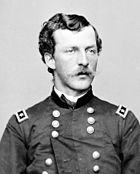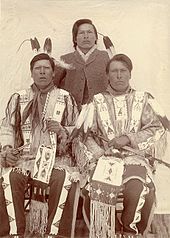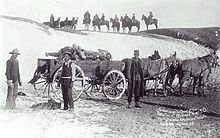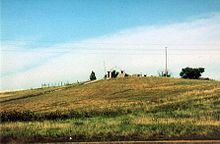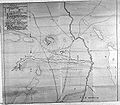- Wounded Knee Massacre
-
Wounded Knee Massacre Part of the Ghost Dance War, Sioux Wars 
Mass grave for the dead Lakota after the massacre at Wounded Knee CreekDate December 29, 1890 Location Wounded Knee Creek, South Dakota Result United States victory, natives massacred Belligerents  United States
United StatesMiniconjou Sioux
Hunkpapa SiouxCommanders and leaders  James W. Forsyth
James W. ForsythSpotted Elk † Strength 7th U.S. Cavalry
four Hotchkiss guns~350 Sioux, the majority of whom were women and children Casualties and losses 25 killed,
39 wounded (6 fatally)153 killed,
51 wounded (some fatally)Native American losses include civilian casualties. Wounded Knee Massacre – Drexel Mission FightThe Wounded Knee Massacre happened on December 29, 1890,[1] near Wounded Knee Creek (Lakota: Čhaŋkpé Ópi Wakpála) on the Lakota Pine Ridge Indian Reservation in South Dakota, USA. On the day before, a detachment of the U.S. 7th Cavalry Regiment commanded by Major Samuel M. Whitside intercepted Spotted Elk's (Big Foot) band of Miniconjou Lakota and 38 Hunkpapa Lakota near Porcupine Butte and escorted them 5 miles westward (8 km) to Wounded Knee Creek where they made camp.
The rest of the 7th Cavalry Regiment arrived led by Colonel James Forsyth and surrounded the encampment supported by four Hotchkiss guns.[2]
On the morning of December 29, the troops went into the camp to disarm the Lakota. One version of events claims that during the process of disarming the Lakota, a deaf tribesman named Black Coyote was reluctant to give up his rifle claiming he had paid a lot for it.[3] A scuffle over Black Coyote's rifle escalated and a shot was fired which resulted in the 7th Cavalry opening fire indiscriminately from all sides, killing men, women, and children, as well as some of their own fellow troopers. Those few Lakota warriors who still had weapons began shooting back at the attacking troopers, who quickly suppressed the Lakota fire. The surviving Lakota fled, but U.S. cavalrymen pursued and killed many who were unarmed.
By the time it was over, at least 150 men, women, and children of the Lakota Sioux had been killed and 51 wounded (4 men, 47 women and children, some of whom died later); some estimates placed the number of dead at 300. Twenty-five troopers also died, and 39 were wounded (6 of the wounded would later die). [4] It is believed that many were the victims of friendly fire, as the shooting took place at close range in chaotic conditions.[5]
The site has been designated a National Historic Landmark.[1]
Contents
Prelude
In the years prior to the Massacre, the U.S. Government continued to coerce the Lakota into signing away more of their lands. The large bison herds, as well as other staple species of the Sioux diet, had been driven nearly to extinction. Congress failed to keep its treaty promises[6] to feed, house, clothe and protect reservation lands from encroachment by settlers and gold miners; as well as failing to properly oversee the Indian Agents. As a result there was unrest on the reservations.[7] It was during this time of suffering and degradation that news spread among the reservations of a Paiute prophet named Wovoka, founder of the Ghost Dance religion. He had a vision that the Christian Messiah, Jesus Christ, had returned to earth in the form of a Native American.[8]
The Messiah would raise all the Native American believers above the earth. During this time the white man would disappear from Native lands, the buffalo herds and all the other animals would return in abundance, and the ghosts of their ancestors would return to earth - hence the word "Ghost" in "Ghost Dance". They would then return to earth to live in peace. This would all be brought about by performance of the "Ghost Dance". Lakota ambassadeurs to Wovoka, Kicking Bear and Short Bull taught the Sioux that while performing the Ghost Dance, they would wear special Ghost Dance shirts as seen by Black Elk in a vision. Kicking Bear said the shirts had the power to repel bullets.[8]
European Americans were alarmed by the sight of the many Great Basin and Plains tribes performing the Ghost Dance, worried that it might be a prelude to armed attack. Among them was the US Indian Agent at the Standing Rock Agency where Chief Sitting Bull lived. US officials decided to take some of the chiefs into custody in order to quell what they called the "Messiah Craze." The military first hoped to have Buffalo Bill, a friend of Sitting Bull, aid in the plan to reduce the chance of violence. Standing Rock agent James McLaughlin overrode the military and sent the Indian police to arrest Sitting Bull.
On December 15, 1890, 40 Indian policemen arrived at Chief Sitting Bull's house to arrest him. Crowds gathered in protest, and the first shot was fired when Sitting Bull tried to pull away from his captors, killing the officer who had been holding him. Additional shots were fired, resulting in the death of Sitting Bull, eight of his supporters and six policemen. After Sitting Bull's death, 200 members of his Hunkpapa band, fearful of reprisals, fled Standing Rock to join Chief Spotted Elk (later to be known as "Big Foot") and his Miniconjou band at the Cheyenne River Indian Reservation.
Spotted Elk and his band, along with 38 Hunkpapa, left the Cheyenne River Reservation on December 23 to journey to the Pine Ridge Indian Reservation to seek shelter with Red Cloud.[9]
Former Pine Ridge Indian agent Valentine T. Mcgillycuddy was asked his opinion of the 'hostilities' surrounding the Ghost Dance movement by General Leonard W. Colby commander of the Nebraska National Guard (portion of letter dated Jan. 15, 1891):[10]
"As for the "Ghost Dance" too much attention has been paid to it. It was only the symptom [sic] or surface indication of a deep rooted, long existing difficulty; as well treat the eruption of small pox as the disease and ignore the constitutional disease."
"As regards disarming the Sioux, however desirable it may appear, I consider it neither advisable, nor practicable. I fear it will result as the theoretical enforcement of prohibition in Kansas, Iowa and Dakota; you will succeed in disarming and keeping disarmed the friendly Indians because you can, and you will not succeed with the mob element because you cannot."
"If I were again to be an Indian Agent, and had my choice, I would take charge of 10,000 armed Sioux in preference to a like number of disarmed ones; and furthermore agree to handle that number, or the whole Sioux nation, without a white soldier. Respectfully, etc., V.T. McGillycuddy.
P.S. I neglected to state that up to date there has been neither a Sioux outbreak or war. No citizen in Nebraska or Dakota has been killed, molested or can show the scratch of a pin, and no property has been destroyed off the reservation."[11]
General Miles' TelegramGeneral Miles sent this telegram from Rapid City to General John Schofield in Washington, D.C. on December 19, 1890:
"The difficult Indian problem cannot be solved permanently at this end of the line. It requires the fulfillment of Congress of the treaty obligations that the Indians were entreated and coerced into signing. They signed away a valuable portion of their reservation, and it is now occupied by white people, for which they have received nothing.
They understood that ample provision would be made for their support; instead, their supplies have been reduced, and much of the time they have been living on half and two-thirds rations. Their crops, as well as the crops of the white people, for two years have been almost total failures.
The dissatisfaction is wide spread, especially among the Sioux, while the Cheyennes have been on the verge of starvation, and were forced to commit depredations to sustain life. These facts are beyond question, and the evidence is positive and sustained by thousands of witnesses."
The Massacre
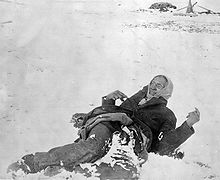 Spotted Elk lies dead after the Wounded Knee Massacre, 1890
Spotted Elk lies dead after the Wounded Knee Massacre, 1890
On December 28, 1890, Chief Spotted Elk of the Miniconjou Lakota nation and 350 of his followers were intercepted by a 7th Cavalry detachment under Major Samuel M. Whitside southwest of the badlands near Porcupine Butte. John Shangreau, a scout and interpreter who was half Sioux, advised that they not be disarmed immediately, as it would lead to violence. The troopers escorted the Lakota about five miles westward (8 km) to Wounded Knee Creek where they made camp. Later that evening, Col. James W. Forsyth and the rest of the 7th Cavalry arrived, bringing the number of troopers at Wounded Knee to 500.[12] In contrast, there were 350 Native Americans, of whom all but 120 were women and children.
The troopers surrounded Spotted Elk's encampment and set up four rapid fire Hotchkiss guns.[13] At daybreak on December 29, 1890, Col. Forsyth ordered the surrender of weapons and the immediate removal and transportation of the Indians from the "zone of military operations" to awaiting trains. Specific details of what triggered the fight are debated. According to some accounts, a medicine man named Yellow Bird began to perform the Ghost Dance, reiterating his assertion to the Lakota that the ghost shirts were bulletproof. As tension mounted, Black Coyote refused to give up his rifle; he was deaf and had not understood the order. Another Indian said: "Black Coyote is deaf." (He did not speak English). When the soldier refused to heed his warning, he said "Stop! He cannot hear your orders!" At that moment, two soldiers seized Black Coyote from behind, and in the struggle (allegedly), his rifle discharged. At the same moment Yellow Bird threw some dust into the air, and approximately five young Lakota men with concealed weapons threw aside their blankets and fired their rifles at Troop K of the 7th. After this initial exchange, the firing became indiscriminate.[14]
Famous Battery "E" of the 1st Artillery. These brave men and the Hotchkiss guns that Big Foot's Indians thought were toys, Together with the fighting 7th what's left of Gen. Custer's boys, Sent 200 Indians to that Heaven which the ghost dancer enjoys. This checked the Indian noise, and Gen. Miles with staff Returned to Illinois." According to commanding Gen. Nelson A. Miles, a "scuffle occurred between one warrior who had [a] rifle in his hand and two soldiers. The rifle was discharged and a massacre occurred, not only the warriors but the sick Chief Spotted Elk, and a large number of women and children who tried to escape by running and scattering over the prairie were hunted down and killed."[15]
At first the struggle was fought at close range; fully half the Indian men were killed or wounded before they had a chance to get off any shots. Some of the Indians grabbed rifles they had been hiding and opened fire on the soldiers. With no cover, and with many of the Sioux unarmed, this phase of the fighting lasted a few minutes at most. While the Indian warriors and soldiers were shooting at close range, other soldiers used the Hotchkiss guns against the tipi camp full of women and children. It is believed that many of the troops on the battlefield were victims of friendly fire from their own Hotchkiss guns. The Indian women and children fled the camp, seeking shelter in a nearby ravine from the crossfire.[16] The officers had lost all control of their men. Some of the soldiers fanned out to run across the battlefield and finish off wounded Indians. Others leaped onto their horses and pursued the Lakota (men, women and children), in some cases for miles across the prairies. By the end of the fighting, which lasted less than an hour, at least 150 Lakota had been killed and 50 wounded. Army casualties numbered 25 dead and 39 wounded.
Eyewitness accounts
- Dewey Beard (Iron Tail, 1862–1955), Minneconjou Lakota survivor: as told to Eli S. Ricker :
"...then many Indians broke into the ravine; some ran up the ravine and to favorable positions for defense."[17]
- Black Elk (1863–1950); medicine man, Oglala Lakota:
"I did not know then how much was ended. When I look back now from this high hill of my old age, I can still see the butchered women and children lying heaped and scattered all along the crooked gulch as plain as when I saw them with eyes young. And I can see that something else died there in the bloody mud, and was buried in the blizzard. A people's dream died there. It was a beautiful dream . . . . the nation's hoop is broken and scattered. There is no center any longer, and the sacred tree is dead." (Source: Black Elk Speaks, c. 1932)
- American Horse (1840–1908); Chief, Oglala Lakota:
"There was a woman with an infant in her arms who was killed as she almost touched the flag of truce...A mother was shot down with her infant; the child not knowing that its mother was dead was still nursing...The women as they were fleeing with their babies were killed together, shot right through...and after most all of them had been killed a cry was made that all those who were not killed or wounded should come forth and they would be safe. Little boys...came out of their places of refuge, and as soon as they came in sight a number of soldiers surrounded them and butchered them there."
- Edward S. Godfrey; Captain; commanded Co. D of the Seventh Cavalry:
"I know the men did not aim deliberately and they were greatly excited. I don't believe they saw their sights. They fired rapidly but it seemed to me only a few seconds till there was not a living thing before us; warriors, squaws, children, ponies, and dogs...went down before that unaimed fire."[18] ( Godfrey was a Lieutenant in Captain Benteen's force during the Battle of the Little Bighorn)[19]
- Hugh McGinnis; First Battalion, Co. K, Seventh Cavalry: General Nelson A. Miles who visited the scene of carnage, following a three day blizzard, estimated that around 300 snow shrouded forms were strewn over the countryside. He also discovered to his horror that helpless children and women with babes in their arms had been chased as far as two miles from the original scene of encounter and cut down without mercy by the troopers. ... Judging by the slaughter on the battlefield it was suggested that the soldiers simply went berserk. For who could explain such a merciless disregard for life?... As I see it the battle was more or less a matter of spontaneous combustion, sparked by mutual distrust....[20]
Aftermath
 Soldiers pose with three of the four Hotchkiss guns used at Wounded Knee. The caption on the photograph reads: Famous Battery "E" of the 1st Artillery. These brave men and the Hotchkiss guns that Big Foot's Indians thought were toys, Together with the fighting 7th what's left of Gen. Custer's boys, Sent 200 Indians to that Heaven which the ghost dancer enjoys. This checked the Indian noise, and Gen. Miles with staff Returned to Illinois."
Soldiers pose with three of the four Hotchkiss guns used at Wounded Knee. The caption on the photograph reads: Famous Battery "E" of the 1st Artillery. These brave men and the Hotchkiss guns that Big Foot's Indians thought were toys, Together with the fighting 7th what's left of Gen. Custer's boys, Sent 200 Indians to that Heaven which the ghost dancer enjoys. This checked the Indian noise, and Gen. Miles with staff Returned to Illinois."
Following a three-day blizzard, the military hired civilians to bury the dead Lakota. The burial party found the deceased frozen; they were gathered up and placed in a common grave on a hill overlooking the encampment from which some of the fire from the Hotchkiss guns originated. It was reported that four infants were found alive, wrapped in their deceased mothers' shawls. In all, 84 men, 44 women, and 18 children reportedly died on the field, while at least seven Lakota were mortally wounded.[21] General Nelson Miles denounced Colonel Forsyth and relieved him of command. An exhaustive Army Court of Inquiry convened by Miles criticized Forsyth for his tactical dispositions but otherwise exonerated him of responsibility. The Court of Inquiry, however, was not conducted as a formal court-martial.
The Secretary of War concurred with the decision and reinstated Forsyth to command of the 7th Cavalry. Testimony had indicated that for the most part, troops attempted to avoid non-combatant casualties. Miles continued to criticize Forsyth, whom he believed had deliberately disobeyed his commands in order to destroy the Indians. Miles promoted the conclusion that Wounded Knee was a deliberate massacre rather than a tragedy caused by poor decisions, in an effort to destroy the career of Forsyth. This was later understood and Forsyth was promoted to Major General.[22]
The American public's reaction to the battle at the time was generally favorable. Many non-Lakota living near the reservations interpreted the battle as the defeat of a murderous cult; others confused Ghost Dancers with Native Americans in general. In an editorial response to the event, the young newspaper editor L. Frank Baum, later the author of The Wonderful Wizard of Oz, wrote in the Aberdeen Saturday Pioneer on January 3, 1891:
The Pioneer has before declared that our only safety depends upon the total extermination of the Indians. Having wronged them for centuries, we had better, in order to protect our civilization, follow it up by one more wrong and wipe these untamed and untamable creatures from the face of the earth. In this lies future safety for our settlers and the soldiers who are under incompetent commands. Otherwise, we may expect future years to be as full of trouble with the redskins as those have been in the past.[23]
Soon after the event, Dewey Beard, his brother Joseph Horn Cloud and others formed the Wounded Knee Survivors Association, which came to include descendants. They sought compensation from the US government for the many fatalities and injured. Today the association is independent and works to preserve and protect the historic site from exploitation, and to administer any memorial erected there. Papers of the association (1890–1973) and related materials are held by the University of South Dakota and available for research.[24] It was not until the 1990s that a memorial to the Lakota Sioux was included in the National Historic Landmark.
More than 80 years after the massacre, beginning on February 27, 1973, Wounded Knee was the site of the Wounded Knee incident, a 71-day standoff between militants of the American Indian Movement, who chose the site for its symbolic value, and federal law enforcement officials.
Drexel Mission Fight
Historically, Wounded Knee is generally considered to be the end of the collective multi-century series of conflicts between colonial and U.S. forces and American Indians, known collectively as the Indian Wars, it was not however the last armed conflict between Native Americans and the United States.
The Drexel Mission Fight was an armed confrontation between Lakota warriors and the United States Army that took place on the Pine Ridge Indian Reservation the day after the massacre on December 30, 1890. The fight occurred on White Clay Creek appoximately 15 mile north of Pine Ridge where Lakota fleeing from the continued hostile situation surrounding the massacre at Wounded Knee set up camp.
Company K of the Seventh Cavalry - the unit involved in the massacre was sent to force their return to the areas they were assigned on their respective reservations, some of the 'hostiles' were Brulé Lakota from the Rosebud Indian Reservation. The Seventh Cavalry was pinned down in a valley by the combined Lakota forces and had to be rescued by the Ninth Cavalry, an African American regiment nicknamed the Buffalo Soldiers.[25]
Among the Lakota warriors was a young Brule from Rosebud named Plenty Horses who had recently returned from five years at the Carlisle Indian School in Pennsylvania. A week after this fight Plenty Horses would shoot and kill Army Lieutenant Edward W. Casey,[26] commandant of the Cheyenne Scouts (Troop L, Eighth Cavalry). The testimony introduced at the trial of Plenty Horses and his subsequent aquittal also helped abrogate the legal culpability of the U.S. Army for the Wounded Knee Massacre.[27]
Medal of Honor controversy
The Army awarded twenty Medals of Honor, its highest award, for the action. Native American activists have urged the medals be withdrawn, as they say they were "Medals of Dishonor". According to Lakota tribesman William Thunder Hawk, "The Medal of Honor is meant to reward soldiers who act heroically. But at Wounded Knee, they didn't show heroism; they showed cruelty." In 2001, the National Congress of American Indians passed two resolutions that condemned the Medals of Honor awards and called on the U.S. government to rescind them.[28]
Historian Will G. Robinson noted that in contrast, only three Medals of Honor were awarded among the 64,000 South Dakotans who fought for four years of World War II.[29]
Some of the citations on the medals awarded to the troopers at Wounded Knee state that they went in pursuit of Lakota who were trying to escape or hide.[30]
Medal of Honor Citations, Wounded KneeTwo of the citations of the twenty Medals of Honor awarded at Wounded Knee: GRESHAM, JOHN C. Rank and organization: First Lieutenant, 7th U.S. Cavalry. Place and date: At Wounded Knee Creek, S. Dak., 29 December 1890. Entered service at: Lancaster Courthouse, Va. Birth: Virginia. Date of issue: 26 March 1895. Citation: Voluntarily led a party into a ravine to dislodge Sioux Indians concealed therein. He was wounded during this action.
SULLIVAN, THOMAS Rank and organization: Private, Company E, 7th U.S. Cavalry. Place and date: At Wounded Knee Creek, S. Dak., 29 December 1890. Entered service at: Newark, N.J. Birth: Ireland. Date of issue: 17 December 1891. Citation: Conspicuous bravery in action against Indians concealed in a ravine.
Remembrance
A church was built on the hill behind the mass grave in which the victims had been buried. In 1903, descendants of those who died in the massacre erected a monument at the gravesite. The memorial lists many of those who died at Wounded Knee along with an inscription that reads:
"This monument is erected by surviving relatives and other Ogalala [sic] and Cheyenne River Sioux Indians in memory of the Chief Big Foot massacre December 29, 1890. Col. Forsyth in command of US troops. Big Foot was a great chief of the Sioux Indians. He often said, "I will stand in peace till my last day comes." He did many good and brave deeds for the white man and the red man. Many innocent women and children who knew no wrong died here.[31]
The Wounded Knee Battlefield was declared a U.S. National Historic Landmark in 1965 and was listed on the U.S. National Register of Historic Places in 1966.
Beginning in 1986, a group began the Big Foot Memorial Riders to continue to honor the victims of the Wounded Knee Massacre. The ceremony has attracted more participants each year and riders live with the cold weather, as well as the lack of food and water, as they retrace the path that their family members took to Wounded Knee. They carry with them a white flag to symbolize their hope for world peace, and to honor and remember the victims so that they will not be forgotten.[21]
Since 1890 survivors and their descendants have sought compensation from the U.S. Government for the dead and wounded, but no one has received a monetary settlement.
Popular culture
The phrase, "Bury my heart at Wounded Knee" comes from the 1931 poem "American Names" by Stephen Vincent Benet. The poem is about Benet's love of American place names and makes no reference to the battle. However, when the line was used as the title of a 1970 book—Bury My Heart at Wounded Knee by historian Dee Brown—it became popularly attached to the incident. Brown's book raised awareness of the massacre and became a best seller.
Its title (Benet's phrase) has since been used many times in songs and other references to the battle. Perhaps the best known is "Bury My Heart at Wounded Knee", written by Buffy Sainte-Marie and featured on her 1992 album Coincidence and Likely Stories.
Other artists who have written or recorded songs referring to the massacre at Wounded Knee include Grant Lee Buffalo( "Were you there? from the album " Storm Hymnal 2001);Johnny Cash (1972's "Big Foot", which is strongly sympathetic); The Indigo Girls (a cover of Sainte-Marie's song); Charlie Parr ("1890" on his 2010 album When the Devil Goes Blind); Manowar ("Spirit Horse Of The Cherokee" from The Triumph Of Steel 1992 album) Nik Kershaw ("Wounded Knee" on his 1989 album The Wors); Southern Death Cult ("Moya"); The Waterboys ("Bury My Heart"); Uriah Heep; Primus; Patti Smith;[32] Robbie Robertson;[33] Five Iron Frenzy; Toad the Wet Sprocket; Marty Stuart; and Bright Eyes.
In 1973, the American rock band Redbone, formed by Native Americans Patrick and Lolly Vasquez, released the song, "We Were All Wounded at Wounded Knee". The song ends with the subtly altered sentence, "We were all wounded by Wounded Knee".[34] The song reached the number one chart position across Europe. In the U.S., the song was initially withheld from release and then banned by several radio stations.
The 1992 film Thunderheart is set at Wounded Knee Creek and was filmed there.
Petri Hiltunen's 2000 graphic novel Aavetanssi ("Ghost Dance", in Finnish) depicted the massacre from a Native American point of view.
The 2004 film Hidalgo begins with the massacre at Wounded Knee Creek. Its premise is that Hopkins, of Lakota descent, was the messenger who delivered the deadly order to the Seventh Cavalry.
The 2005 film Into the West included scenes of the massacre.
In 2007, HBO Films released a film adaptation of the Dee Brown bestseller Bury My Heart at Wounded Knee.
Gallery
See also
- List of massacres in South Dakota
References
- ^ a b "National Historic Landmarks Program: Wounded Knee". National Park Service. http://tps.cr.nps.gov/nhl/detail.cfm?ResourceId=540&ResourceType=Site. Retrieved 2008-01-10.
- ^ Liggett, Lorie (1998). "Wounded Knee Massacre - An Introduction". Bowling Green State University. http://www.bgsu.edu/departments/acs/1890s/woundedknee/WKIntro.html. Retrieved 2007-03-02..
- ^ Randy Parsons. "The Wounded Knee Massacre - December 1890". Lastoftheindependents.com. http://www.lastoftheindependents.com/wounded.htm. Retrieved 2011-08-17.
- ^ Wounded Knee & the Ghost Dance Tragedy by Jack Utter p. 25 Publisher: National Woodlands Publishing Company; 1st edition (April 1991) Language: English ISBN 0-9628075-1-6
- ^ Strom, Karen (1995). "The Massacre at Wounded Knee". Karen Strom. http://www.hanksville.org/daniel/lakota/Wounded_Knee.html.
- ^ Hall, Kermit L (ed.), The Oxford Guide to the Supreme Court of the United States, Oxford Press, 1992; section: "Native Americans", page 580 ISBN 0-19-505835-6
- ^ To this day the Sioux have refused to accept compensation for the Black Hills land seized from them. A 1980 Supreme Court decision (United States v. Sioux Nation of Indians) ruled the taking was illegal and awarded compensation, increased by interest to $757 million dollars, but not the return of the land which the Sioux sought. The Lakota have refused to take the money, demanding, instead, the return of their sacred lands.
- ^ a b "Wovoka." PBS: New Perspectives on the West. (retrieved 6 August 2010)
- ^ Viola, Herman J. Trail to Wounded Knee: The Last Stand of the Plains Indians 1860-1890. Washington, D.C.: National Geographic Society, 2003.
- ^ Annual report, Part 2 By Smithsonian Institution. Bureau of American Ethnology, John Wesley Powell, Matthew Williams pgs.831-833 (1896)
- ^ The ghost-dance religion and the Sioux outbreak of 1890, by James Mooney, p. 833
- ^ Russell, Major Samuel L., "Selfless Service: The Cavalry Career of Brigadier General Samuel M. Whitside from 1858 to 1902." MMAS Thesis, Fort Leavenworth: U.S. Command and General Staff College, 2002.
- ^ Axelrod, Alan. (1993) Chronicles of the Indian Wars: From Colonial Times to Wounded Knee. (p. 254).
- ^ Utley, Robert (1963). "The Last Days of the Sioux Nation". Yale University Press. http://yalepress.yale.edu/yupbooks/book.asp?isbn=9780300103168. Retrieved 2007-08-04.
- ^ Phillips, Charles. December 29, 1890. American History. Dec 2005 40(5) pp. 16-68.
- ^ Bateman, Robert (June 2008), "Wounded Knee", Military History 24 (4): 62–67
- ^ Eli Seavey Ricker, Voices of the American West: The Indian interviews of Eli S. Ricker, 1903-1919
- ^ Edward S. Godfrey, "Cavalry Fire Discipline," Journal of the Military Service Institution of the United States 19 (1896): 259.
- ^ William S. E. Coleman, Voices of Wounded Knee, p.278
- ^ Hugh McGinnis, "I Took Part In The Wounded Knee Massacre", Real West Magazine, January 1966; at Our Family History Website
- ^ a b Josephy, Jr., Alvin M., Trudy Thomas, and Jeanne Eder. Wounded Knee: Lest We Forget. Billings, Montana: Buffalo Bill Historical Center, 1990.
- ^ Ostler, Jeffrey. (2004) The Plains Sioux and U.S. Colonialism from Lewis and Clark to Wounded Knee. (p. 354).
- ^ Giago, Tim. "300 reasons not to forget lessons of Wounded Knee", Manataka American Indian Council. (retrieved 6 Aug 2010)
- ^ "Wounded Knee Survivors Association, Papers (1890-1973)", Archives and Special Collections, University of South Dakota, accessed 7 June 2011
- ^ Jeffrey Ostler: The Plains Sioux and U.S. colonialism from Lewis and Clark to Wounded Knee pgs. 357-358, Cambridge University Press (2004) ISBN 0521605903
- ^ Congressional edition By United States. Congress p.132. 2011-04-26. http://books.google.com/books?id=NEBHAQAAIAAJ&pg=PA132&dq=plenty+horses#v=onepage&q=plenty%20horses&f=false. Retrieved 2011-08-17.
- ^ Roger L. Di Silvestro: In the Shadow of Wounded Knee: The Untold Final Story of the Indian Wars p.198, Walker & Company (2007) ISBN 0802715141
- ^ "Lakota~WOUNDED KNEE: A Campaign to Rescind Medals: story, pictures and information". Footnote.com. http://www.footnote.com/page/1299_lakotawounded_knee_a_campaign_to/. Retrieved 2011-08-17.
- ^ Doctor Sally Wagner Testifies At Wounded Knee Hearings Part Two.
- ^ "U.S. Army Indian Wars, Medal of Honor citations". History.army.mil. http://www.history.army.mil/html/moh/indianwars.html. Retrieved 2011-08-17.
- ^ The Last days of the Sioux Nation, by Robert M. Utley, p.5 Publisher: Yale University Press; 2 edition (July 11, 2004) Language: English ISBN 0-300-10316-6
- ^ Patti Smith Group, "Ghost Dance". On Easter, Arista AB 4171, released 1978.
- ^ Robbie Robertson, "Ghost Dance", on Music for the Native Americans, Cema/Capitol 28295, 1994.
- ^ "We Were All Wounded At Wounded Knee", Redbone's unofficial discography site, with lyrics. Webpage found 2010-03-31.
Further reading
- Andersson, Rani-Henrik. The Lakota Ghost Dance of 1890, University of Nebraska Press, 2009.ISBN 978-0-8032-1073-8.
- Brown, Dee. Bury My Heart at Wounded Knee: An Indian History of the American West, Owl Books (1970). ISBN 0-8050-6669-1.
- Coleman, William S.E. Voices of Wounded Knee, University of Nebraska Press (2000). ISBN 0-8032-1506-1.
- Smith, Rex Alan. Moon of Popping Trees, University of Nebraska Press (1981). ISBN 0-8032-9120-5.
- Utley, Robert M. Last Days of the Sioux Nation, Yale University Press (1963).
- Utley, Robert M. The Indian Frontier 1846-1890, University of New Mexico Press (2003). ISBN 0-8263-2998-5.
- Utley, Robert M. Frontier Regulars The United States Army and the Indian 1866-1891, MacMillan Publishing (1973). ISBN 0-8032-9551-0.
- Yenne, Bill. Indian Wars: The Campaign for the American West, Westholme (2005). ISBN 1-59416-016-3.
- Champlin, Tim. A Trail To Wounded Knee : A Western Story, Five Star (2001). ISBN 0-7826-2401-0.
External links
- The Wounded Knee Museum in Wall, South Dakota
- Bureau of American Ethnology report on the Ghost Dance Religion, PBS
- "Walter Mason Camp Collection," includes photographs from the Battle of Wounded Knee Creek, Brigham Young University
- US Army Casualty list of Wounded Knee, GenForum
- "A Dark Day" - Education Resource, Dakota Pathways
- "Lost Bird of Wounded Knee" - Education Resource, South Dakota Public Television
- Review: Bury My Heart At Wounded Knee, HBO production, Friends of the Little Big Horn
- Susanna L.J. Red Bear, Find-a-Grave
- Lost Bird of Wounded Knee (1890-1919), Find-a-Grave
- "THE GHOST DANCE.; HOW THE INDIANS WORK THEMSELVES UP TO FIGHTING PITCH", eyewitness account by reporter, New York Times, 22 November 1890
U.S. National Register of Historic Places Topics Lists by states Alabama • Alaska • Arizona • Arkansas • California • Colorado • Connecticut • Delaware • Florida • Georgia • Hawaii • Idaho • Illinois • Indiana • Iowa • Kansas • Kentucky • Louisiana • Maine • Maryland • Massachusetts • Michigan • Minnesota • Mississippi • Missouri • Montana • Nebraska • Nevada • New Hampshire • New Jersey • New Mexico • New York • North Carolina • North Dakota • Ohio • Oklahoma • Oregon • Pennsylvania • Rhode Island • South Carolina • South Dakota • Tennessee • Texas • Utah • Vermont • Virginia • Washington • West Virginia • Wisconsin • WyomingLists by territories Lists by associated states Other  Category:National Register of Historic Places •
Category:National Register of Historic Places •  Portal:National Register of Historic PlacesCategories:
Portal:National Register of Historic PlacesCategories:- Battles involving Native Americans
- Conflicts in 1890
- Conflicts in 1891
- History of South Dakota
- Lakota
- Mass graves
- Massacres of Native Americans
- Native American history of South Dakota
- National Historic Landmarks in South Dakota
- Pine Ridge Campaign
- Sioux
- Sioux Wars
- 1890 in South Dakota
- 1890 in the United States
- 19th-century colonization of the Americas
Wikimedia Foundation. 2010.


